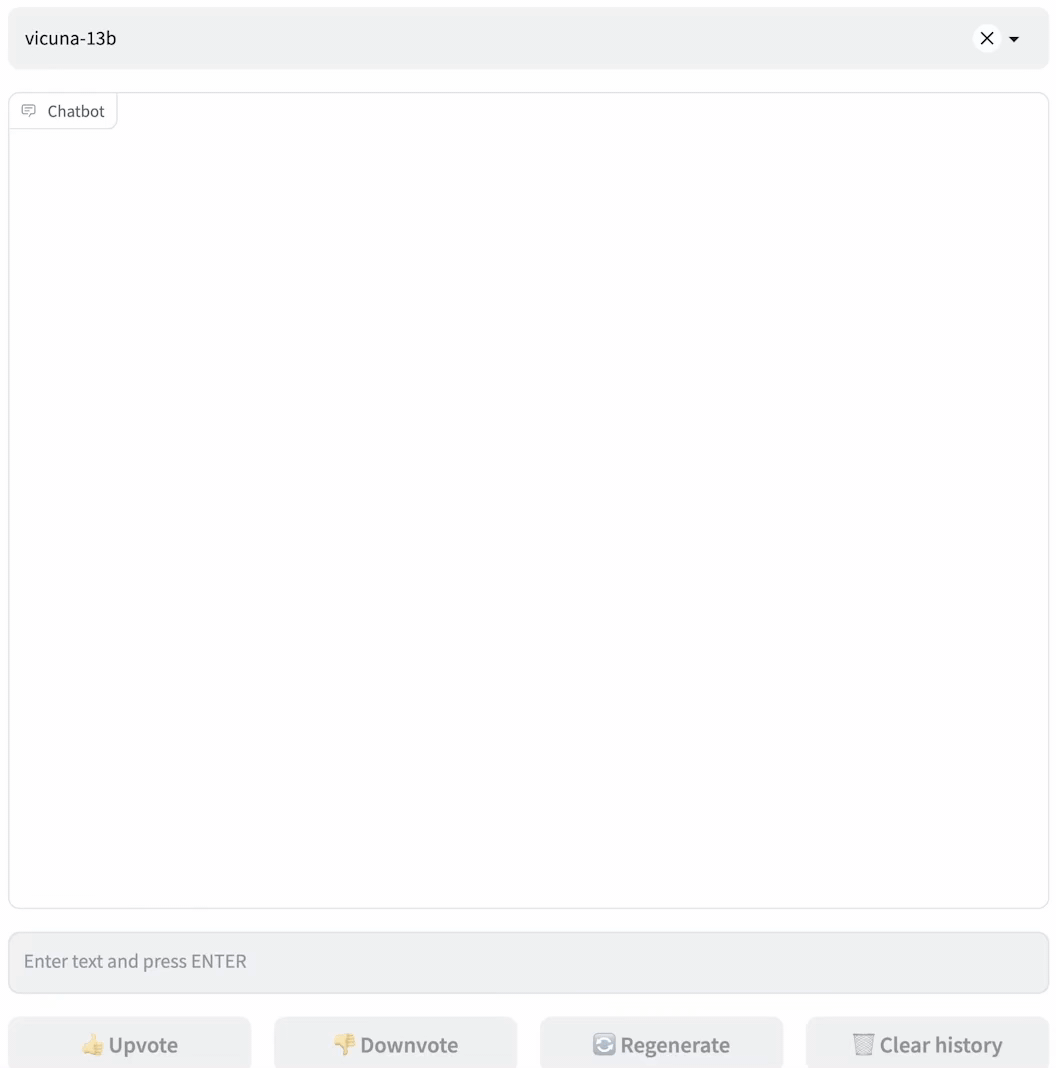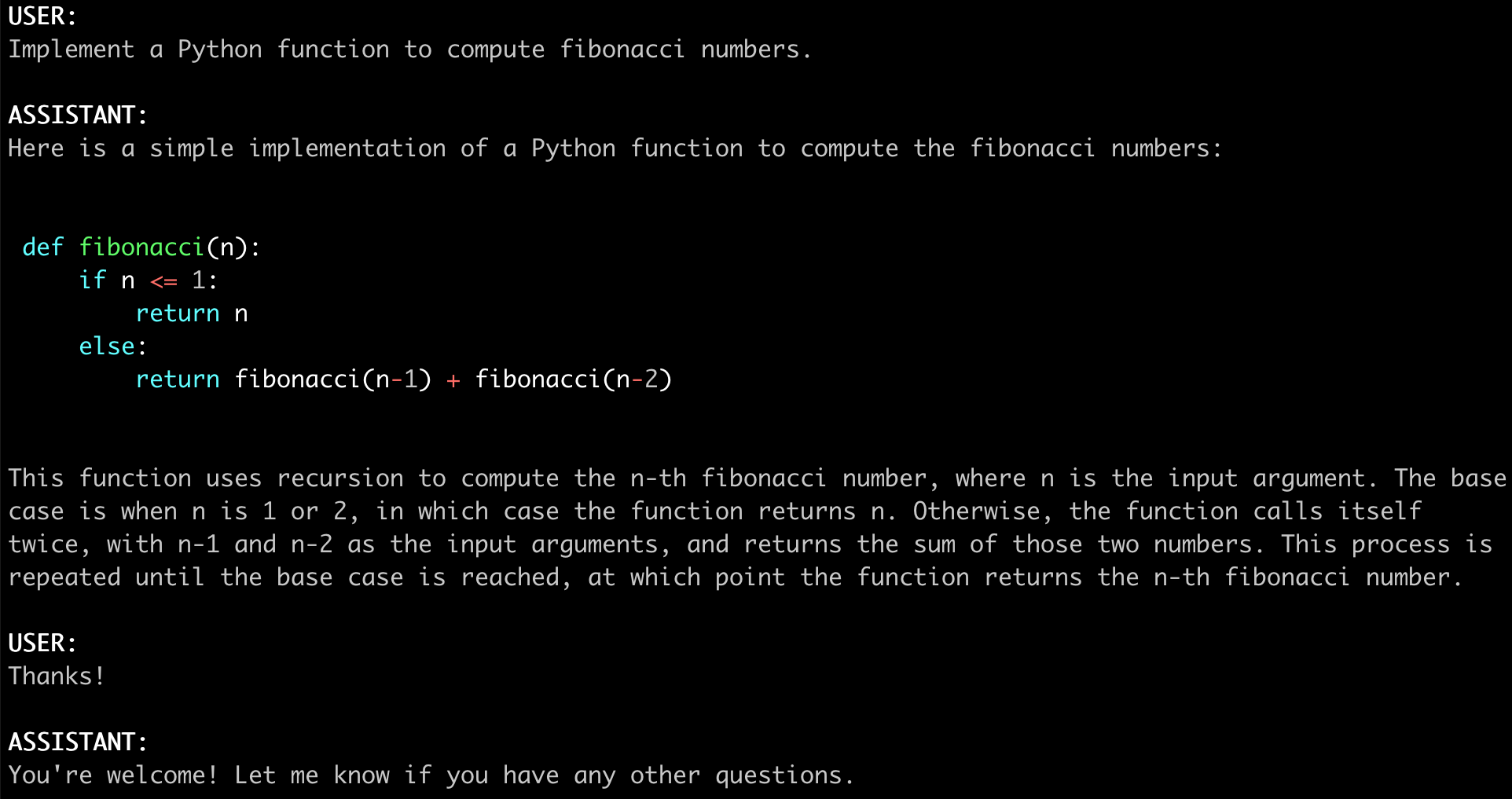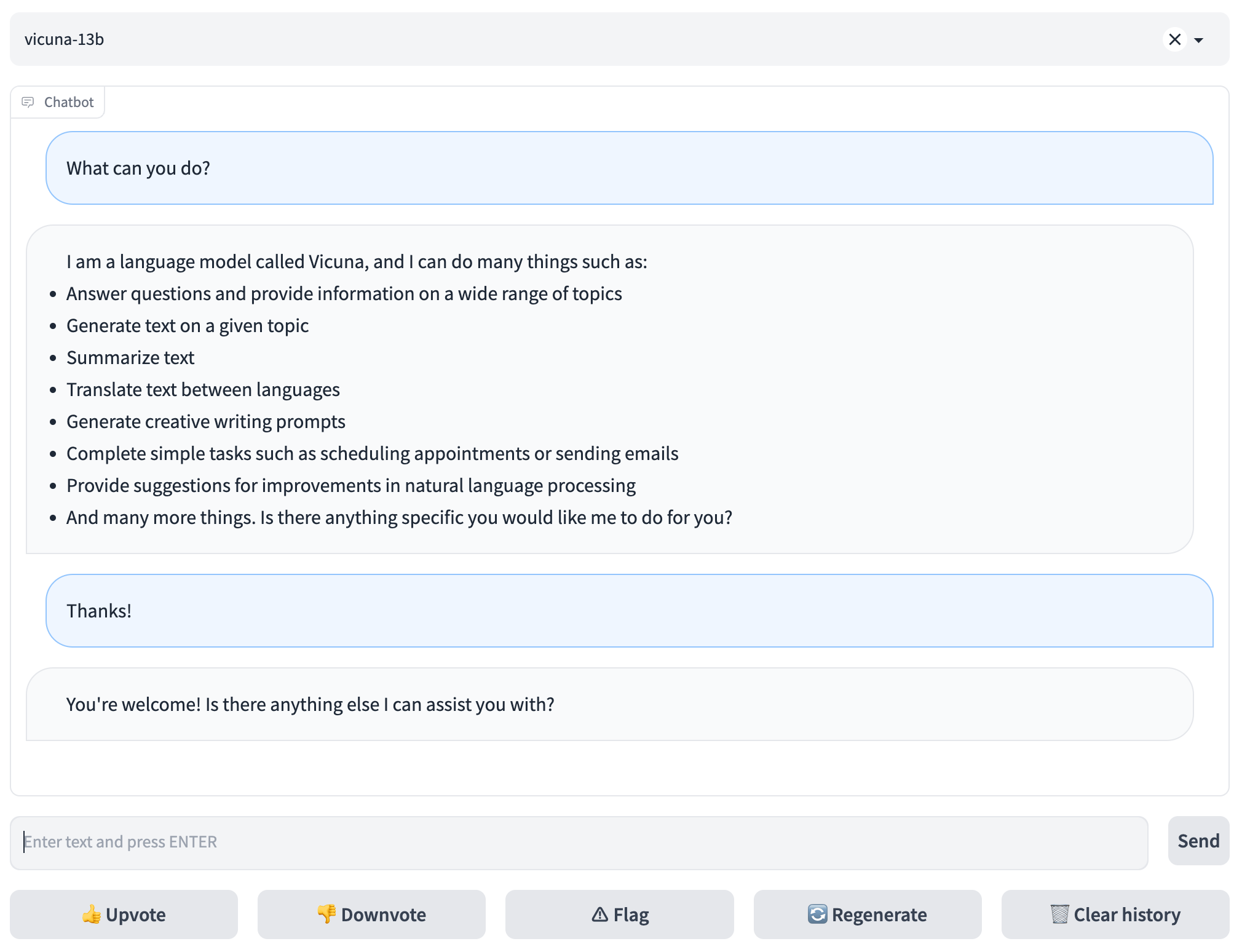| Demo | Arena | Discord | Twitter |
FastChat is an open platform for training, serving, and evaluating large language model based chatbots. The core features include:
- The weights, training code, and evaluation code for state-of-the-art models (e.g., Vicuna, FastChat-T5).
- A distributed multi-model serving system with web UI and OpenAI-compatible RESTful APIs.
- [2023/05] 🔥 We introduced Chatbot Arena for battles among LLMs. Check out the blog post and demo.
- [2023/04] We released FastChat-T5 compatible with commercial usage. Check out the weights and demo.
- [2023/03] We released Vicuna: An Open-Source Chatbot Impressing GPT-4 with 90% ChatGPT Quality. Check out the blog post and demo.
- Install
- Model Weights
- Inference with Command Line Interface
- Serving with Web GUI
- API
- Evaluation
- Fine-tuning
- Citation
pip3 install fschat- Clone this repository and navigate to the FastChat folder
git clone https://github.com/lm-sys/FastChat.git
cd FastChatIf you are running on Mac:
brew install rust cmake- Install Package
pip3 install --upgrade pip # enable PEP 660 support
pip3 install -e .We release Vicuna weights v1.3 as merged weights directly. You do not need to apply delta. Vicuna is based on LLaMA and should be used under LLaMA's model license.
You can use the commands below to start chatting. It will automatically download the weights from Hugging Face repos. See more command options and how to handle out-of-memory in the "Inference with Command Line Interface" section below.
| Size | Chat Command | Hugging Face Repo |
|---|---|---|
| 7B | python3 -m fastchat.serve.cli --model-path lmsys/vicuna-7b-v1.3 |
lmsys/vicuna-7b-v1.3 |
| 13B | python3 -m fastchat.serve.cli --model-path lmsys/vicuna-13b-v1.3 |
lmsys/vicuna-13b-v1.3 |
| 33B | python3 -m fastchat.serve.cli --model-path lmsys/vicuna-33b-v1.3 |
lmsys/vicuna-33b-v1.3 |
Old weights: see docs/vicuna_weights_version.md for all versions of weights and their differences.
Simply run the command below to start chatting. It will automatically download the weights from a Hugging Face repo.
python3 -m fastchat.serve.cli --model-path lmsys/fastchat-t5-3b-v1.0(Experimental Feature: You can specify --style rich to enable rich text output and better text streaming quality for some non-ASCII content. This may not work properly on certain terminals.)
FastChat supports a wide range of models, including Vicuna, Alpaca, Baize, ChatGLM, Dolly, Falcon, FastChat-T5, GPT4ALL, Guanaco, MTP, OpenAssistant, RedPajama, StableLM, WizardLM, and more.
See a complete list of supported models and instructions to add a new model here.
The command below requires around 14GB of GPU memory for Vicuna-7B and 28GB of GPU memory for Vicuna-13B.
See the "No Enough Memory" section below if you do not have enough memory.
--model-path can be a local folder or a Hugging Face repo name.
python3 -m fastchat.serve.cli --model-path lmsys/vicuna-7b-v1.3
You can use model parallelism to aggregate GPU memory from multiple GPUs on the same machine.
python3 -m fastchat.serve.cli --model-path lmsys/vicuna-7b-v1.3 --num-gpus 2
This runs on the CPU only and does not require GPU. It requires around 30GB of CPU memory for Vicuna-7B and around 60GB of CPU memory for Vicuna-13B.
python3 -m fastchat.serve.cli --model-path lmsys/vicuna-7b-v1.3 --device cpu
Use --device mps to enable GPU acceleration on Mac computers (requires torch >= 2.0).
Use --load-8bit to turn on 8-bit compression.
python3 -m fastchat.serve.cli --model-path lmsys/vicuna-7b-v1.3 --device mps --load-8bit
Vicuna-7B can run on a 32GB M1 Macbook with 1 - 2 words / second.
Install the Intel Extension for PyTorch. Set the OneAPI environment variables:
source /opt/intel/oneapi/setvars.sh
Use --device xpu to enable XPU/GPU acceleration.
python3 -m fastchat.serve.cli --model-path lmsys/vicuna-7b-v1.3 --device xpu
Vicuna-7B can run on an Intel Arc A770 16GB.
If you do not have enough memory, you can enable 8-bit compression by adding --load-8bit to commands above.
This can reduce memory usage by around half with slightly degraded model quality.
It is compatible with the CPU, GPU, and Metal backend.
Vicuna-13B with 8-bit compression can run on a single NVIDIA 3090/4080/T4/V100(16GB) GPU.
python3 -m fastchat.serve.cli --model-path lmsys/vicuna-7b-v1.3 --load-8bit
In addition to that, you can add --cpu-offloading to commands above to offload weights that don't fit on your GPU onto the CPU memory. This requires 8-bit compression to be enabled and the bitsandbytes package to be installed, which is only available on linux operating systems.
- FastChat supports GPTQ 4bit inference with GPTQ-for-LLaMa. See docs/gptq.md.
- MLC LLM, backed by TVM Unity compiler, deploys Vicuna natively on phones, consumer-class GPUs and web browsers via Vulkan, Metal, CUDA and WebGPU.
To serve using the web UI, you need three main components: web servers that interface with users, model workers that host one or more models, and a controller to coordinate the webserver and model workers. You can learn more about the architecture here.
Here are the commands to follow in your terminal:
python3 -m fastchat.serve.controllerThis controller manages the distributed workers.
python3 -m fastchat.serve.model_worker --model-path lmsys/vicuna-7b-v1.3Wait until the process finishes loading the model and you see "Uvicorn running on ...". The model worker will register itself to the controller .
To ensure that your model worker is connected to your controller properly, send a test message using the following command:
python3 -m fastchat.serve.test_message --model-name vicuna-7b-v1.3You will see a short output.
python3 -m fastchat.serve.gradio_web_serverThis is the user interface that users will interact with.
By following these steps, you will be able to serve your models using the web UI. You can open your browser and chat with a model now. If the models do not show up, try to reboot the gradio web server.
- You can register multiple model workers to a single controller, which can be used for serving a single model with higher throughput or serving multiple models at the same time. When doing so, please allocate different GPUs and ports for different model workers.
# worker 0
CUDA_VISIBLE_DEVICES=0 python3 -m fastchat.serve.model_worker --model-path lmsys/vicuna-7b-v1.3 --controller http://localhost:21001 --port 31000 --worker http://localhost:31000
# worker 1
CUDA_VISIBLE_DEVICES=1 python3 -m fastchat.serve.model_worker --model-path lmsys/fastchat-t5-3b-v1.0 --controller http://localhost:21001 --port 31001 --worker http://localhost:31001
- You can also launch a multi-tab gradio server, which includes the Chatbot Arena tabs.
python3 -m fastchat.serve.gradio_web_server_multiFastChat provides OpenAI-compatible APIs for its supported models, so you can use FastChat as a local drop-in replacement for OpenAI APIs. The FastChat server is compatible with both openai-python library and cURL commands. See docs/openai_api.md.
See fastchat/serve/huggingface_api.py.
See docs/langchain_integration.
Our AI-enhanced evaluation pipeline is based on GPT-4. This section provides a high-level summary of the pipeline. For detailed instructions, please refer to the evaluation documentation.
-
Generate answers from different models: Use
qa_baseline_gpt35.pyfor ChatGPT, or specify the model checkpoint and runget_model_answer.pyfor Vicuna and other models. -
Generate reviews with GPT-4: Use GPT-4 to generate reviews automatically. This step can also be performed manually if the GPT-4 API is not available to you.
-
Generate visualization data: Run
generate_webpage_data_from_table.pyto generate data for a static website, which allows you to visualize the evaluation data. -
Visualize the data: Serve a static website under the
webpagedirectory. You can usepython3 -m http.serverto serve the website locally.
We use a data format encoded with JSON Lines for evaluation. The format includes information on models, prompts, reviewers, questions, answers, and reviews.
You can customize the evaluation process or contribute to our project by accessing the relevant data.
For detailed instructions, please refer to the evaluation documentation.
Vicuna is created by fine-tuning a LLaMA base model using approximately 70K user-shared conversations gathered from ShareGPT.com with public APIs. To ensure data quality, we convert the HTML back to markdown and filter out some inappropriate or low-quality samples. Additionally, we divide lengthy conversations into smaller segments that fit the model's maximum context length. For detailed instructions to clean the ShareGPT data, check out here.
Due to some concerns, we may not release the ShareGPT dataset at the moment. If you would like to try the fine-tuning code, you can run it with some dummy conversations in dummy_conversation.json. You can follow the same format and plug in your own data.
Our code is based on Stanford Alpaca with additional support for multi-turn conversations. We use similar hyperparameters as the Stanford Alpaca.
| Hyperparameter | Global Batch Size | Learning rate | Epochs | Max length | Weight decay |
|---|---|---|---|---|---|
| Vicuna-13B | 128 | 2e-5 | 3 | 2048 | 0 |
You can use the following command to train Vicuna-7B with 4 x A100 (40GB).
torchrun --nproc_per_node=4 --master_port=20001 fastchat/train/train_mem.py \
--model_name_or_path ~/model_weights/llama-7b \
--data_path data/dummy_conversation.json \
--bf16 True \
--output_dir output_vicuna \
--num_train_epochs 3 \
--per_device_train_batch_size 2 \
--per_device_eval_batch_size 2 \
--gradient_accumulation_steps 16 \
--evaluation_strategy "no" \
--save_strategy "steps" \
--save_steps 1200 \
--save_total_limit 10 \
--learning_rate 2e-5 \
--weight_decay 0. \
--warmup_ratio 0.03 \
--lr_scheduler_type "cosine" \
--logging_steps 1 \
--fsdp "full_shard auto_wrap" \
--fsdp_transformer_layer_cls_to_wrap 'LlamaDecoderLayer' \
--tf32 True \
--model_max_length 2048 \
--gradient_checkpointing True \
--lazy_preprocess TrueIf you meet out-of-memory during model saving, see solutions here.
You can use the following command to train FastChat-T5 with 4 x A100 (40GB).
torchrun --nproc_per_node=4 --master_port=9778 fastchat/train/train_flant5.py \
--model_name_or_path google/flan-t5-xl \
--data_path /data/dummy.json \
--bf16 True \
--output_dir ./checkpoints_flant5_3b \
--num_train_epochs 3 \
--per_device_train_batch_size 1 \
--per_device_eval_batch_size 1 \
--gradient_accumulation_steps 4 \
--evaluation_strategy "no" \
--save_strategy "steps" \
--save_steps 300 \
--save_total_limit 1 \
--learning_rate 2e-5 \
--weight_decay 0. \
--warmup_ratio 0.03 \
--lr_scheduler_type "cosine" \
--logging_steps 1 \
--fsdp "full_shard auto_wrap" \
--fsdp_transformer_layer_cls_to_wrap T5Block \
--tf32 True \
--model_max_length 2048 \
--preprocessed_path ./preprocessed_data/processed.json \
--gradient_checkpointing True You can use the following command to train Vicuna-7B using QLoRA using ZeRO2. Note that ZeRO3 is not currently supported with QLoRA but ZeRO3 does support LoRA, which has a reference configuraiton under playground/deepspeed_config_s3.json.
deepspeed train_lora.py \
--model_name_or_path ~/model_weights/llama-7b \
--lora_r 8 \
--lora_alpha 16 \
--lora_dropout 0.05 \
--data_path <path-to-data> \
--bf16 True \
--output_dir ./checkpoints \
--num_train_epochs 3 \
--per_device_train_batch_size 4 \
--per_device_eval_batch_size 4 \
--gradient_accumulation_steps 1 \
--evaluation_strategy "no" \
--save_strategy "steps" \
--save_steps 1200 \
--save_total_limit 100 \
--learning_rate 2e-5 \
--weight_decay 0. \
--warmup_ratio 0.03 \
--lr_scheduler_type "cosine" \
--logging_steps 1 \
--tf32 True \
--model_max_length 2048 \
--q_lora True \
--deepspeed playground/deepspeed_config_s2.json \After training, please use our post-processing function to update the saved model weight. Additional discussions can be found here.
SkyPilot is a framework built by UC Berkeley for easily and cost effectively running ML workloads on any cloud (AWS, GCP, Azure, Lambda, etc.). Find SkyPilot documentation here on using managed spot instances to train Vicuna and save on your cloud costs.
The code (training, serving, and evaluation) in this repository is mostly developed for or derived from the paper below. Please cite it if you find the repository helpful.
@misc{zheng2023judging,
title={Judging LLM-as-a-judge with MT-Bench and Chatbot Arena},
author={Lianmin Zheng and Wei-Lin Chiang and Ying Sheng and Siyuan Zhuang and Zhanghao Wu and Yonghao Zhuang and Zi Lin and Zhuohan Li and Dacheng Li and Eric. P Xing and Hao Zhang and Joseph E. Gonzalez and Ion Stoica},
year={2023},
eprint={2306.05685},
archivePrefix={arXiv},
primaryClass={cs.CL}
}
We are also planning to add more of our research to this repository.


